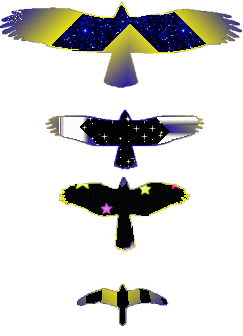
|
Lorna Mills and Sally McKay
Digital Media Tree this blog's archive OVVLvverk Lorna Mills: Artworks / Persona Volare / contact Sally McKay: GIFS / cv and contact |
View current page
...more recent posts

I love this bit from Bruno Latour (Reassembling the Social : An Introduction to Actor-Network-Theory, pp.89-90)
...in all domains, to say that something is constructed has always been associated with an appreciation of its robustness, quality, style, durability, worth, etc. So much so that no one would bother to say that a skyscraper, a nuclear plant, a sculpture, or an automobile is ‘constructed’. This is too obvious to be pointed out. The great questions are rather: How well designed is it? How solidly constructed is it? How durable or reliable is it? How costly is the material? Everywhere, in technology, engineering, architecture, and art, construction is so much a synonym for the real that the question shifts immediately to the next and really interesting one: Is it well or badly constructed? At first, it seemed obvious to us— the early science students— that if there existed building sites where the usual notion of constructivism should be readily applied, it had to be the laboratories, the research institutes, and their huge array of costly scientific instruments. Even more so than in art, architecture, and engineering, science offered the most extreme cases of complete artificiality and complete objectivity moving in parallel. There could be no question that laboratories, particle accelerators, telescopes, national statistics, satellites arrays, giant computers, and specimen collections were artificial places the history of which could be documented in the same way as for buildings, computer chips, and locomotives. And yet there was not the slightest doubt that the products of those artificial and costly sites were the most ascertained, objective, and certified results ever obtained by collective human ingenuity. This is why it was with great enthusiasm that we began using the expression ‘construction of facts’ to describe the striking phenomenon of artificiality and reality marching in step. Moreover, to say that science, too, was constructed gave the same thrill as with all the other ‘makings of’: we went back stage; we learned about the skills of practitioners; we saw innovations come into being; we felt how risky it was; and we witnessed the puzzling merger of human activities and non-human entities.
Unfortunately, the excitation went quickly sour when we realized that for other colleagues in the social as well as natural sciences the word construction meant something entirely different from what common sense had thought until then. To say that something was ‘constructed’ in their minds meant that something was not true. They seemed to operate with the strange idea that you had to submit to this rather unlikely choice: either something was real and not constructed, or it was constructed and artificial, contrived and invented, made up and false. Not only could this idea not be reconciled with the sturdy meaning one had in mind when talking about a ‘well constructed’ house, a ‘well designed’ software, or a ‘well sculpted’ statue, but it flew in the face of everything we were witnessing in laboratories: to be contrived and to be objective went together.